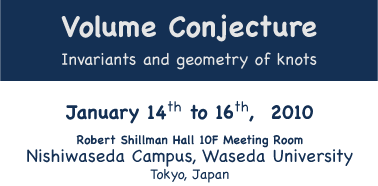
| Back | Top | Archive | Abstracts | Access | Waseda University |

Abstracts
Volume conjecture of colored Jones polynomials
Jinseok Cho (Waseda University, JSPS fellow)
Y. Yokota showed wonderful relation between complex volumes of hyperbolic knot complements and Kashaev's invariants of the knots, using extended Bloch group theory. In this talk, we will show similar relation holds for colored Jones polynomials of twist knots. This is a joint work with J. Murakami.
Modified 6j-Symbols and 3-Manifold Invariants
Nathan Geer (Utah State University)
In these talks I will discuss a renormalization of the Reshetikhin-Turaev quantum invariants, by "modified quantum dimensions" and their use in defining 3-Manifold invariants. In the case of quantized simple Lie algebras with generic quantum parameters these "modified quantum dimensions" are proportional to the genuine quantum dimensions. More interestingly, there are examples where the genuine quantum dimensions vanish but the "modified quantum dimension" are non-zero and lead to non-trivial link invariants. In these talks, I will focus on such an example arising from the nilpotent representations of quantized sl(2) at a root of unity. The invariants associated to this example contain the generalized multivariable Alexander invariants defined by Akutsu, Deguchi and Ohtsuki and Kashaev’s quantum dilogarithm invariants of knots. Finally, I will use this example to explain how these renormalized invariants led to modified 6j-symbols and 3-manifolds. To do this I will present the Turaev-Viro construction of an invariant of 3-manifolds. It is based on a state sum associated to a triangulation of this manifold. This is a sum over all isomorphism class of simple objects of a modular category. Then I will say how one can modify this construction to fit with the context of nilpotent representations of quantized sl(2) at a root of unity. The main obstacle is that this example has infinitly many non-isomorphic simple representations. The work discussed in these talks is closely related to the Volume Conjecture. This is joint work with Bertrand Patureau-Mirand and Vladimir Turaev.
Quandle and hyperbolic volume
Ayumu Inoue (Tokyo Institute of Technology)
A quandle is an algebraic system having a self-distributive binary operation whose definition is motivated by knot theory. Carter et al. developed homology theory of quandles to define invariants of knots, called quandle cocycle invariants. An arc coloring of a diagram of a knot is a map from arcs of the diagram to a quandle satisfying some condition. A region coloring of the diagram is a map from regions of the diagram to a set, which is equipped with a right action of the quandle, satisfying some condition. A shadow coloring is a pair of an arc coloring and a region coloring. Associated with a shadow coloring, we obtain a second homology class. Thus, the result of the Kronecker product between the homology class and a ``good'' cohomology class should reflects properties of a knot. In this talk, we show that hyperbolic volume can be viewed as a quandle cocycle. The result of the Kronecker product is the volume of a hyperbolic knot. It gives us a criterion for determining invertibility and positive/negative amphicheirality of hyperbolic knots.
The volume and the Chern-Simons invariant of a PSL(2,C)-representation and quandle homology
Yuichi Kabaya (Osaka City University Advanced Mathematical Institute)
A quandle is a set with a binary operation like conjugation in a group. A homology theory of quandles is defined. We can associate a 2-cycle for a knot diagram, which is an invariant of the knot and its coloring.
In this talk, we introduce a construction of the element of the extended Bloch group for a knot complement from the quandle 2-cycle. This is a joint work with Ayumu Inoue.
The colored Jones polynomial of a torus knot and its representations to SL(2;C)
Hitoshi Murakami (Tokyo Institute of Thechnology)
We show that for a torus knot, we can relate its colored Jones polynomial to the SL(2;C) Chern-Simons invariants and the twisted Reidemeister torsions of irreducible representations of the fundamental group of the knot complement to SL(2;C). This is a joint work with K. Hikami.
The volume conjecture for graphs and cables
Roland van der Veen (University of Amsterdam)
In this series of lectures we explore the volume conjecture from two points of view: graphs and cables. The first two lectures deal with the generalization of the volume conjecture by replacing knots by embedded knotted graphs. We will show how this leads to both interesting toy models for studying the volume conjecture and a proof of the original conjecture for an infinite family of links. In the third lecture we ask how the volume conjecture behaves under the operation of cabling (replacing a knot by a torus knot embedded on its tubular neighborhood). We present a formula for the colored Jones polynomial of a cabled knot and discuss its consequences for the volume conjecture.
On the complex volume of hyperbolic knots
Yoshiyuki Yokota (Tokyo Metropolitan University)
In this talk, we give a formula of the complex volumes of hyperbolic knot complements, which is related to the volume conjecture for hyperbolic knots. We also discuss the complex volumes of 3-manifolds obtained by Dehn surgeries on hyperbolic knots.
The extended Bloch group and the Chern-Simons invariant
Christian Zickert (University of California, Berkeley)
We describe a combinatorial formula for the Chern-Simons invariant of a hyperbolic 3-manifold, and more generally, a 3-manifold equiped with a parabolic PSL(2,C)-representation. The formula utilizes Neumann's extended Bloch group, which we describe in detail.
| Back | Top | Archive | Abstracts | Access | Waseda University |

Organizer : Jun Murakami (Waseda Univ.), Jinseok Cho (Waseda Univ.)
Contact: murakami(at)waseda.jp